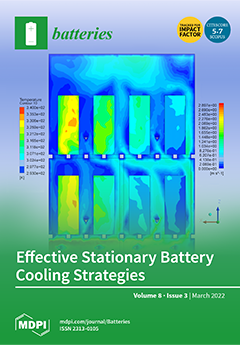Due to great interest in the development of electric vehicles and other applications, improving the performances of lithium-ion batteries (LIBs) is crucial. Specifically, components of electrolytes for LIBs should be adequately chosen from hundreds of thousands of candidate compounds. In this study, we
[...] Read more.
Due to great interest in the development of electric vehicles and other applications, improving the performances of lithium-ion batteries (LIBs) is crucial. Specifically, components of electrolytes for LIBs should be adequately chosen from hundreds of thousands of candidate compounds. In this study, we aimed to evaluate some physical properties expected for combinations of molecules for electrolytes by microscopic simulations. That is, the viscosity, ionic conductivity, degree of dissociation, diffusion coefficient, and conformation of each molecule were analyzed via molecular dynamics (MD) simulations. We aimed to understand how molecular-sized structures and properties collaboratively affect the behavior of electrolytes. The practical models of molecules we used were ethylene carbonate (EC), fluoroethylene carbonate (FEC), propylene carbonate (PC), butylene carbonate (BC), γ-butyrolactone (GBL), γ-valerolactone (GVL), dimethyl carbonate (DMC), ethyl-methyl carbonate (EMC), diethyl carbonate (DEC), and lithium hexafluorophosphate (LiPF
6). Many molecular systems of electrolytes were simulated, in which one molar LiPF
6 was mixed into a single or combined solvent. It was found that small solvent molecules diffused with relative ease, and they contributed to the higher ionic conductivity of electrolytes. It was clarified that the diffusion coefficient of lithium (Li) ions is greatly affected by the surrounding solvent molecules. We can conclude that high-permittivity solvents can be selectively coordinated around Li ions, and Li salts are sufficiently dissociated, even when there is only a small content of high-permittivity solvent. Thus, we can confirm solely by MD simulation that one of the better candidates for solvent molecules, formamide (F), will exhibit higher performance than the current solvents.
Full article





